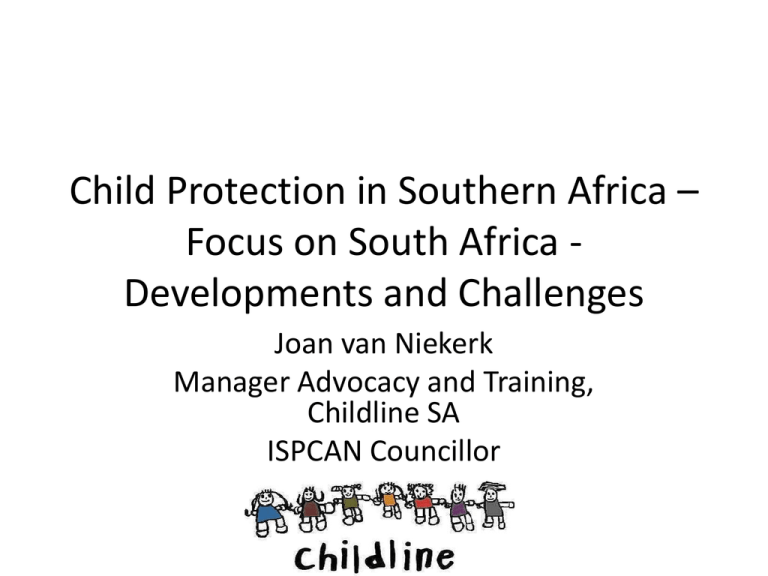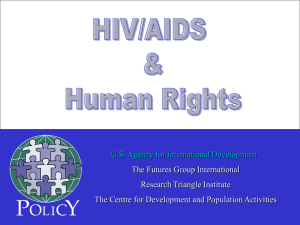
Child Protection in Southern Africa –
Focus on South Africa Developments and Challenges
Joan van Niekerk
Manager Advocacy and Training,
Childline SA
ISPCAN Councillor
Introduction
• This presentation will focus on
- The Country context in which Child Protection
Services are offered
- Recent developments in law and policy that
frame and drive Child Protection in South
Africa
- Conclusions and recommendations emerging
from recent research into how the Child
Protection System is functioning in practice.
The Country and Region
South Africa
- Is strategically significant in terms of geographical
position and developed economy in relation to
other countries in the Southern African region
although it remains a developing country.
- This attracts the attention of and funding from
the “big powers” – eg the USA.
- However this attention and input is not always
driven by real needs on the ground – but
sometimes by self interest.
South Africa
• Has areas, flora and fauna that is breathtaking in its beauty
• This has contributed to high levels of tourism
and activities related to tourism
• Tourism contributed to the development of
our economy and contributed to job creation
in impoverished and rural communities as well
as in cities and towns
South Africa – the economy
• According to the Human Development Index South
Africa has one of the fastest growing gaps between the
rich and the poor, and since the demise of apartheid
has seen the development of a small black economic
elite.
• However most economists and social analyists agree
that the policy of “Black Economic Empowerment has
benefitted a small select and politically connected
group and that the bulk of the population, previously
disadvantaged by the policy of Apartheid (separate
development) remain impoverished.
South Africa – the economy
• Unemployment remains high – at about 40%
and since the advent of the World Soccer Cup,
job losses continue to rise.
• At present there are about 5.8 million
taxpayers who are employed supporting about
13 million social grant recipients – an
unsustainable situation.
The HIV and AIDS Pandemic
• South Africa has the highest number of HIV+ and
AIDS infected persons of any country in the world
• About 16% of our population is infected
• The impact on children is enormous – and
orphanhood – either the loss of a mother/father or
both has compromised the lives of almost 2 million
children
• Research indicates that the loss of a mother is more
significant because of non-support and the absence
of fathers.
The impact of the HIV and AIDS
Pandemic
• The crisis of orphanhood had a huge impact on
the child protection system
• Resources were diverted into providing some
institutional and mainly foster care for orphaned
children
• This led to the neglect of child abuse and the
intentional neglect of children until the link
between orphanhood and rising levels of abuse
and intentional neglect was acknowledged.
South Africa – the continued
impact of apartheid history
• The impact of apartheid on family life and the
care and protection of children was, and
continues to be enormous
• Migrant labour and the pass law system
separated economically active men and
women from their families – particularly men
• This, combined with urbanisation negatively
impacted on the extended family unit which
historically provided a safety net for children.
Developments since the demise of
Apartheid
With the demise of apartheid and the advent of
democracy, South Africa was accepted back into the
international community
This enabled the country to become a signatory to the
UN Convention
However much of the law and policy regulating the
care and protection of children had been developed
under the apartheid system and therefore
compromised the care and protection of children.
Child Protection services were unevenly distributed
The process of improving child
protection services
• In order to address the inequalities and problems in
the field of child care and protection South Africa
embarked on a process of
- comprehensive law reform.
- Costing services and assessing available resources
- Developing norms and standards for service
provision
- Moving towards the improvement of implementation
- Monitoring and evaluating implementation of law,
policy and implementation
Law and Policy Reform
• Three laws focussing on the care and
protection of children were developed
- The Children’s Act – providing for the civil
aspects of development, care, preventive
services, early intervention, statutory care and
placement and services to promote the
rehabilitation and reintegration of families
where appropriate.
Law and Policy Reform
- The Child Justice Act – providing for the special care,
protection, rehabilitation and reintegration of
children in conflict with the Law
- The Criminal Law (Sexual Offences and Related
Matters) Amendment Act – extending the range and
definitions of sexual crimes against children, and
establishing more child friendly processes relating to
the management of child victims of sexual crimes.
Law and Policy Reform
• The National HIV and AIDS Strategic plan was
formulated . This
- Recognised the particular vulnerability of children
- Rolled out an improved prevention of mother to
child infection programme
- Rolled out a comprehensive ARV programme for HIV
and AIDS infected adults and children
- Rolled out a national HIV and AIDS testing
programme to improve early detection and care of
infected persons
Law and Policy reform
• The HIV and AIDS National Strategic Plan has
demonstrated positive benefits.
The latest national health and social
development statistics indicate that
- The rate of infection appears to have
“bottomed out”
- Infections of children at birth or through
breastfeeding have reduced
- The rate of orphaning has slowed
Law Reform
• Whilst many child protection professionals believe
that law reform has brought many benefits to Child
Protection, there are those that believe that the
process did not go far enough.
• Many of the earlier drafts of legislation were more
comprehensive.
• However political and economic interests
contributed to the removal of significant provisions –
for example more comprehensive social security for
children, the Children’s Umbudsman.
Some of the issues raised today
• Corporal punishment – banned in schools and all public
institutions – but still very common in schools
• Mandatory reporting – differs across the three pieces of
legislation – limited in the Children’s Act, universal in the
Sexual offences Act
• Registers – provisions overlap – resulting in multiple registers
• Strong emphasis on prevention and early intervention
• Strong emphasis on justice responses to child abuse
• Registry – rarely used.
Paper Tigers?
• Law reform is all very well – but unless
implemented is what might be called a “paper
tiger”
• Eg mandated reporting – reporting into a
vacuum may put the child further at risk.
• Also embedding child protection services in
justice processes is very limiting.
Implementation of Law and Policy
in relation to Child Protection
• Although passed in 2005, the implementation of the
Children’s Act was delayed until April 2010.
• Contributing factors included
- Delays in the development of policy to drive
implementation
- The deteriorating global and national economic
situation, which contributed to the lack of resources
for implementaion
- The focus on preparations for the World Soccer Cup
further diverted scarce resources to this event
Implementation of Law and Policy
in relation to Child Protection
• One of the most retro-gressive steps in child
protection service provision over the past
decade was the disbanding of the South
African Police Service Child Protection Units
despite active lobbying from Child Protection
Experts.
• As a result of the public pressure, the units
were to be re-instated in April 2010 – this did
not occur and a further reinstatement date
has been committed – April 2011.
Implementation – The Children’s
Act
• Remains slow and piecemeal
• Remains compromised by
- the lack of resources - both financial and trained and
competent personnel
- A lack of training on the Act itself of the range and
number of child protection personnel who are
responsible for implementation
• Government has embarked on developing and
implementing a policy to develop and retain “Scarce
Skills” which includes the training and deployment of
social workers in particular.
Implementation – The Child Justice
Act
• Implementation began on 1st April 2010 but has
been hampered by
- Scarce resources – especially diversion
programmes for children diverted away from
criminal justice processes into remedial care
- A lack of training of implementing role-players
A national research effort has been established to
identify further factors in slow implementation
and make recommendations to address this.
Implementation – The Sexual
Offences Act
Implementation began on 1st April 2008.
Child protection workers have generally
welcomed the new definitions of sexual
crimes against children.
However again there are challenges in
implementation that do compromise the care,
protection and healing of children.
These challenges include (inter
alia)
• Corruption in the criminal justice system
• The lack of specialised Child Protection Police
resulting in poor investigation practices that are not
child friendly
• The time delays experienced in bringing matters to
trial or conclusion – this stretches into years for most
children
• The belief among some child protection workers and
prosecutors that therapy should be delayed until
court processes have been concluded.
Further challenges
• Although integrated response protocols to
child abuse and neglect were developed in the
late 1990’s these policies were not universally
implemented at the time, have never been
updated, and have generally fallen into disuse.
Recent research into the Child
Protection System in SA
• Conducted in 2009/10
• In all provinces
• Focussed groups of Child Protection Personnel
across all disciplines – police, prosecutors,
judicial officers, social workers, health
workers, traditional leaders, etc.
• Questionnaires
• Children both inside and outside of the CPS
• Foster and Safe House Care Parents
Recent research into the Child
Protection System in SA - Conclusions
• There is a strong commitment from many
who work in the child protection system in
South Africa to contributing to strengthening
effective proactive and reactive child
protection systems and activities. Most of the
participants in this study reflected a sincere
commitment to the protection of children’s
rights
Research conclusions
• There are many positives in the present
system that can be built on and extended.
•
• However the system at present is
uncoordinated, with a lack of clear provincial
and district leadership.
Research conclusions
• The lack of functional and updated protocols
and coordinating systems contribute to a lack
of coordination, collaboration,
communication, accountability, possible
duplication and unaddressed gaps in services
that should be providing comprehensive
protection of the rights of children and the
appropriate responses and care of children
whose rights have been compromised.
Research Conclusions
• The lack of record keeping and information
management, inclusive of the low level of
reporting to the child protection register,
contributes to the difficulties in assessing the
need for resources for child protection
services and planning the deployment of what
(limited) resources do exist.
Research conclusions
• An absence of clear monitoring and evaluation
mechanisms shared by all role-players in the child
protection system contributes to a lack of clear
knowledge as to what interventions really work and
are efficient and effective in all 4 pillars of child
protection services – prevention, early intervention,
statutory intervention and rehabilitation and
reintegration. This results in those resources that are
available not being used in the most cost efficient
and effective manner.
Research Conclusions
• Children with disability and in rural areas
remain marginalised with regard to service
delivery.
• Corruption and intimidation of role-players,
communities, families and children interfere
with the protection of children’s rights in the
majority of provinces.
Research Conclusions
• Political agendas appear to interfere with the
optimal use of what resources do exist and there is a
lack of passionate political will and leadership
relating to the protection of children’s rights. Strong
political leadership is needed to drive
implementation of law and policy, ensure that
adequate resources are committed to
implementation and that all role-players in the child
protection system are held accountable for their
performance or lack thereof.
Recommendations that emerged
from the study
• The conclusions and recommendations of the Global Study
are more widely distributed in South Africa.
• Political leaders in government are lobbied actively to
remind them of South Africa’s commitment to the protection
of children’s rights through the ratification of the United
Nations Convention on the Rights of the Child, the African
Charter on the Rights and Welfare of the Child, and their
participation in the United Nations commitment to implement
the recommendations of the Global Study on Violence Against
Children. Children must be put high on the agenda of
politicians.
Recommendations
• A further scrutiny of law and policy is required to ensure that
South Africa’s domestic legislation and policy complies with the
comprehensive protection of children’s rights and the protection of
children from ALL forms of violence, including neglect.
• There is an urgent need to re-establish inter-sector child protection
committees in all the provinces and districts, and to ensure that
these committees are inclusive of representatives of all sectors,
including civil society organisations. As it is recognised that
government structures are sometimes challenged with
implementing, coordinating and managing these committees, it is
recommended that the committee structures are co-chaired and
co-managed by civil society.
Recommendations
• Child protection committees at every level must meet regularly,
minute their meetings, distribute these minutes and document
their activities to ensure accountability and facilitate broad
participation. All sectors should be given the opportunity to
contribute to the agendas of meetings and participate in meetings.
• The Child Protection Protocols must be resurrected, revisited,
revised, and committed to. All sectors involved in child protection
services must be invited to participate in this process and political
leaders and Directors-General of key government sectors need to
be brought on board in order to ensure that the protocols are not
“paper tigers” but are implemented and all role-players are held
accountable for non-compliance.
Recommendations
• and information management must be implemented
to ensure that South Africa’s scarce resources are
applied in the most effective, and cost-efficient
programmes and processes.
• Anonymous reporting of child rights violations
should be actively followed up, and a clear and
effective whistle-blowing policy and opportunity
should be provided to assist with the eradication of
corruption and intimidation.
Recommendations
• Current prevention strategies must be evaluated for
their effectiveness and efficiency. Mass Campaigns in
particular require evaluation. Scarce resources must
be used for those prevention strategies that
contribute to effective prevention of child abuse.
More well resourced activities, and programmes
need to be directed at prevention and early
intervention in order to prevent the greater costs
(both financial and to the optimal development of
children and family life) of statutory intervention,
rehabilitation and reintegration.
Thank you !
joanvn@iafrica.com
joanvn@childlinesa.org.za







